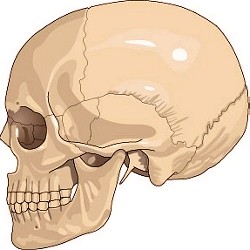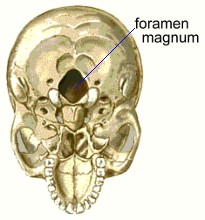The Skull The skull protects the brain, houses the sense organs as well as the entrance to the respiratory and digestive tracts, and provides attachments for muscles of the head and neck.
The skull is made up of bones forming the head, face and jaw.
The skull protects the brain, houses the sense organs as well as the entrance to the respiratory and digestive tracts, and provides attachments for muscles of the head and neck.
The skull is made up of bones forming the head, face and jaw. There are eight bones that surround your brain; together these form the cranium. Its bones include a frontal bone, two parietal bones, two temporal bones, one occipital bone, one sphenoid bone and one ethmoid bone. There are 14 bones in the face, as well as 3 small bones in each ear. At the bottom of the skull is the lower jaw bone, which is attached on each side by a hinge joint.  A large opening called the foramen magnum, located underneath, is where the spinal column enters the head. There are also smaller holes in the skull called foramina, where nerves and blood vessels enter the cranium.
A large opening called the foramen magnum, located underneath, is where the spinal column enters the head. There are also smaller holes in the skull called foramina, where nerves and blood vessels enter the cranium.
The places in the skull where the bones come together are called sutures. These sutures are flexible in young children. After a baby is born, the soft bones that form the cranium are still growing together; by the age of eighteen months the bones have met and the sutures begin to harden. |